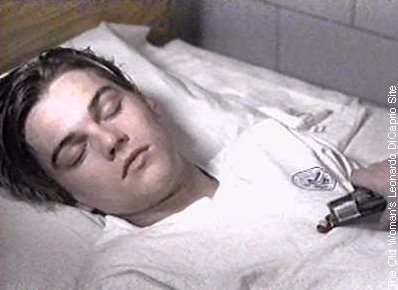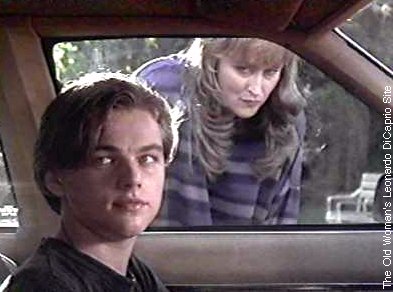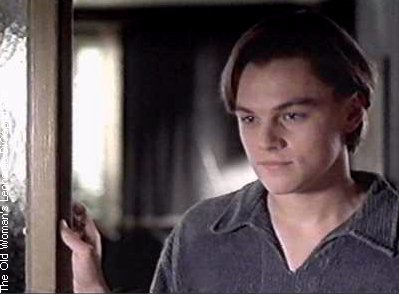

Marvin's Room
This 1996 film boasted a stellar cast comprised of Meryl Streep, Leonardo DiCaprio, Diane Keaton, Robert DeNiro, Hume Cronin, and Gwen Verdon.
THE PLOT: Bessie (Keaton) cares for her Parkinsons-ridden father, Marvin (Cronin), and aging aunt (Verdon) in her home, and is devastated to discover that she herself has become afflicted with leukemia. Although they have been separated for decades, Bessie calls upn her sister, Lee (Streep) and her family to come to Florida and undergo testing for a possible bone marrow transplant.
Struggling to make a life for herself and her two sons, Lee had become so entirely estranged from her sister and father, that when she mentions to her son, Hank (DiCaprio), that "Aunt Bessie" might be dying, he doesn't know who his mother is talking about. Making matters more difficult is the fact that Hank has been confined to a mental institution because he's run out of control and burned down his mother's house. Nevertheless, Lee gets permission to take Hank out of the hospital long enough for him to go to Florida with her and his brother Charlie, meet Bessie, and be tested as a possible marrow donor.
At first defiant and looking for "the angle", Hank delays being tested for the transplant, while he puts Bessie's love and intentions to the test. Most telling is the use of "glass" to separate Hank from the "untrustworthy" adults around him. The adults can see him through the windows of the car, or through the glass panels at the doctor's office, but they can't touch him, can't reach him without his permission. It's only when he comes out from behind the glass, that viewers (and the adults in the film) get a glimpse of the tender and vulnerable young man behind the self-imposed facade of arrogance and faux "lunacy".
Eventually, the two start to warm to one another, and Hank slowly allows his Aunt Bessie to see beyond the transparent barriers of rage and bravado he's built up around himself. Later, he becomes despondent when he discovers that his marrow is not compatible with his aunt's.
As the story unfolds, viewers also learn more about the characters: Lee has been through a series of bad relationships, including one to the man who fathered Hank and his brother. Hank discovers that his father, whom he idolizes but hasn't seen since he was four, used to beat him whenever Lee left Hank alone with his dad. And Bessie discovers that for all Lee's posturing and seemingly selfishness, Lee is a strong woman who's just trying to figure out how to live her life and be happy in it.
By the end of the film, everyone begins to trust and appreciate one another... and Lee makes the selfless decision to remain in Florida, and rebuild and care for her family.
OUR REVIEW: This isn't one of DiCaprio's best or most challenging role, but he embues Hank with enough raw emotion and underlying vulnerability to make him an interesting and believable character. To see Hank evolve from the violent teenager who had to be restrained by the police and drugged into submission at the beginning of the film, to the bright and passionate young man who takes his ailing Aunt Bessie on a joy-ride along the beach front and tries to exlain to her the hurt and fear he experienced in the mental institution is thoroughly satisfying. The fact that we care what Hank thinks and feels is a credit to DiCaprio's ability.
There are moments of sheer joy, worry, and heart-touching sadness in this film, which explores and exposes the realities of human fear, selfishness, selflessness, and familial love.
OTHERS REVIEWS:
From Mr. Showbiz on the web: "...Easy to see, as early as two minutes in, why this film attracted such a forty-carat cast. The characters are intense and authentic, and the story is driven entirely by their feelings and how they act on them.... Streep and DiCaprio are especially convincing as a mother and son because, even at war, they are matched heavyweights in terms of talent. Without ever stooping to any obvious gestures, they both make us feel the sorrow under their identical, highly defensive bouts of selfish behavior... Marvin's Room is a remarkable paradox: a comedy about pain. The anguish and laughter are both genuine." --F.X. Feeney









Back to our MAIN PAGE.
DISCLAIMER: All of the written text and animated GIFs associated with this site are the sole property of TheOldWoman, unless noted otherwise, and may not be reproduced in whole or in part without Mare's permission. All of the images associated with this site are the sole property of the original filmmakers and/or photographers, unless noted otherwise, and are reproduced here under the auspices of "fair use" of copyrighted materials to accent reviews, promote the projects of Leonardo DiCaprio, and entertain his fans. No, I cannot reproduce hard copies of the images for you, so please do not ask. FYI: For those of you who have asked, most of the images created for this site were done so with the help of the SNAPPY Video Snapshot program and the GIF Construction Set program available on the net.
TO GET A COPY OF THIS VIDEO, try your local video outlets, or Blockbuster Video, Columbia House Video, or Reel Video on the web.